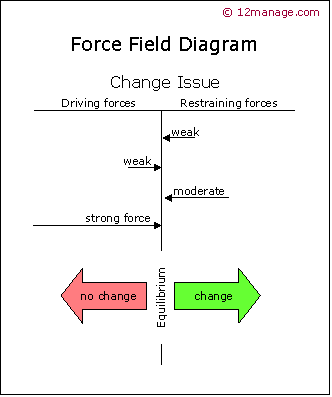Kurt Lewin
Kurt Lewin était un socio-psychologue américain. Il a participé à la science des dynamiques de groupe et en recherche active, et il est considéré comme l'un des fondateurs de la psychologie moderne. Mais Lewin est peut-être plus connu pour avoir développer l'Analyse du champ de force et les Diagrammes du Champ de Force.
Point de vue de Lewin sur les organisations
Selon Kurt Lewin, un problème donné est maintenu en équilibre grâce à l'interaction de deux ensembles de forces en opposition. Celles cherchant à favoriser le changement : les forces d'entraînement. Et celles essayant de préserver le statu quo : les forces de rétention. Lewin a regardé les organisations comme des systèmes dans lesquels la situation actuelle n'était pas un modèle statique. Mais un équilibre dynamique (« Equilibrium ») de forces fonctionnant dans des sens opposés. Afin que n'importe quel changement se produise, les forces d'entraînement doivent excéder les forces de rétention, déplaçant ainsi le point d'équilibre. Comparez : La Théorie des Catastrophes.
Le Diagramme du Champ de Force

Le Diagramme du Champ de Force est un modèle établi sur cette idée que les forces de changement sont dual, à la fois d'entraînement et de rétention Ces forces incluent : les personnes, les habitudes, les coutumes, et les attitudes. Un Diagramme du Champ de Force peut être utilisé à n'importe quel niveau : personnel, projet, organisationnel, réseau, pour visualiser les forces qui peuvent fonctionner en faveur et contre les initiatives de changement. Le diagramme aide son utilisateur à décrire la « guerre » entre les forces autour d'un problème donné. Habituellement, un changement programmé sur un problème donné est décrit en haut. En dessous de ceci, il y a deux colonnes. Les forces d'entraînement (Driving forces) sont énumérées dans la colonne gauche, et les forces de rétention (Restraining forces) dans la colonne droite. Des flèches sont figurées vers le milieu. Les flèches les plus longues indiquent des forces plus fortes (strong force). L'idée est de comprendre, et de rendre explicite, toutes les forces agissant sur un problème donné.
Utilisation de la méthode d'Analyse du champ de force
- Étudiez l'équilibre du pouvoir impliqué dans une question.
- Identifiez les acteurs les plus importants (partenaires) et les groupes cibles pour une campagne sur le problème donné.
- Identifiez les adversaires et les alliés.
- Identifiez comment vous pouvez influencer chaque groupe cible
Étapes dans Analyse du champ de force ? Processus
- Décrivez la situation actuelle.
- Décrivez la situation désirée.
- Identifiez où la situation actuelle ira si aucune mesure n'est prise.
- Énumérez toutes les forces d'entraînement au changement vers la situation désirée.
- Énumérez toutes les forces résistantes au changement vers la situation désirée.
- Examinez et interrogez toutes les forces : sont-elles valides ? Peuvent-elles être changées ? Quels sont les critiques ?
- Allouez des points à chacune des forces employant une échelle numérique par exemple 1 est extrêmement faible et 10 est extrêmement fort.
- Dressez une carte des forces. Énumérez les forces d'entraînement du côté gauche. Et énumérez les forces de rétention du côté droit.
- Déterminez si le changement est viable et si les progrès peuvent se produire.
- Examinez comment le changement peut être affecté en diminuant l'intensité des forces de rétention ou en accroissant l'intensité des forces d'entraînement.
- Rappelez-vous qu'accroître les forces d'entraînement ou diminuer les forces de rétention peut accroître ou diminuer d'autres forces ou même en créer de nouvelles.
|
Cours sur Analyse du Champ de Force.

Cours pour Débutants
|

Cours Avancé
|

Cours pour Experts
|
|
|
|
Les sujets les mieux notés sur Analyse du Champ de Force. Vous trouverez ici les idées les plus précieuses et des suggestions pratiques.

|
Origin of Force Field Analysis
I seem to remember from my early days in OD that Lewin based his model on engineering principles of force analysis taught in Statics and Dynamics of Forces in Mechanical Design. For example, in desig...
 6  4 commentaires
|
|
|
|
Idées avancées sur Force Field Analysis (Anglais). Vous trouverez ici des conseils professionnels d'experts.

Conseils de Consultation
|

Conseils Pédagogiques
|

Conseils Pratiques de Mise en �uvre
|
|
|

|
Concerns Against Change and their Remedies Change Management, Organizational Change
According to Ken Blanchard in the article “Mastering the Art of Change” (Training Journal, January 2010), it is importan...
|

|
Leadership Strategies for Change Initiate, implement, develop and sustain change
In response to the high rate of change failure, Ken Blanchard and his team have developed the Blanchard Leading Through ...
|

|
The Next Steps when FFA is Done... Actions to Take after a Force Field Analysis, FFA Implementation
After the analysis is done and the existing forces have been identified and rated, action can be planned and undertaken ...
|

|
The Force of Employees in Change Inititiaves Why Acknowledging the Power of Employees is Important
The concept of bases of social power is very important for organizations in the context of change initiatives.
The sour...
|

|
Implementing Force Field Analysis in the Strategy Process Practical Guidelines, Best Practices
In his article "Force Field Analysis: A New Way to Evaluate Your Strategy", J. Thomas established seven guidelines usefu...
|

|
Industry’s Driving Forces Organizational Change
Many events can affect an industry powerfully enough to qualify as driving forces. Some are unique and specific to a par...
|

|
Describing and Analyzing Driving Forces FFA Implementation
When analyzing potential trends or driving forces, for them to be relevant they must have at least one effect on the ter...
|

|
Assessing the Risks of Change and the Organization’s Capacity for Change Leading Change
In their book "Transforming Public and Nonprofit Organization – Stewardship for Leading Change", James Edwin Kee and Kat...
|

|
Unfreezing, Moving, Freezing Change Management
In the early 20th century, psychologist Kurt Lewin identified three phases/stages of change that are still the basis of ...
|

|
Strategic Change: Why, What, When, Who and How Preparing Strategic Change
If we need to change strategically, we need to think about why, what, when, who and how:
- Why do we want to change? - ...
|

|
Typical Driving Forces Examples
Typical driving forces include: felt need for change, regulation change, decreasing results, organizational crisis, bonu...
|

|
Typical Restraining Forces Examples
Typical restraining forces include: inertia, apathy, technology, IT, rigidity, fear for the new, budgets, hostility, dis...
|
|
|
|
Diverses sources d'informations sur Analyse du Champ de Force. Vous trouverez ici des powerpoints, des vidéos, des actualités, etc. à utiliser dans vos propres conférences et ateliers.

|
Framing in the Context of Conflicts Framing, Negotiation, Collective Bargaining, Stakeholder Analysis, Force Field Analysis, Conflict Management
Framing and conflicts
This presentation elaborates on the extent to which framing relates to conflicts (and its resolut...
|

|
Force Field Analysis Force Field Analysis
Good explanation about FFA by Vivek Birla. The author describes the concept and the main view of the inventor Lewin. Aft...
|

|
Dealing with Strong Resisters Dealing with Resistance to Change, Change Management, Training, Workshop
Dr. John Kotter gives remarkable advice on dealing with "No, No, People" (strong resisters in change initiatives).
Acco...
|

|
Getting Started with Force Field Analysis Force Field Analysis, Change Management, Problem Solving
To make a decision you can make a list of the PROs and the CONs. But since the issues aren't equally important, it will ...
|

|
Applying Creative Thinking to Complex Business Problem Solving Creative Thinking, Problem Solving, Complex Problem Solving Techniques
This presentation focuses on creative thinking as a useful tool for dealing with complex business issues. It includes th...
|

|
Managing Organizational Change Change Management, Leading Change, Organizational Development
This is a presentation about the ways to manage change. The presentation includes the following sections:
1. Introducti...
|

|
22 Best Practices in Change Management Change Management, Organizational Change
Presentation starts with short introduction of managing organizational change and then outlines 22 best practices in cha...
|

|
Force Field Analysis Diagram Force Field Analysis
Download and edit the 12manage PowerPoint model for limited personal, educational and business use.
Republishing in int...
|
|
|
|
Outils utiles concernant Analyse du Champ de Force.

Nouvelles
|

Vidéos
|

Présentations
|
| |

Livres
|

Académique
|

Plus
|
|
|
|
Comparez l'Analyse du champ de force avec : Iceberg de Gestion du Changement | Théorie des Catastrophes | Analyse des Partenaires | La Carte des Partenaires | RACI | Equation du Changement | Bases Sociales de la Puissance | Fondement DICE | Gestion de Crise | Changement des Cultures d'Organisation | Types de culture | Théorie du Noyau Dur | Théorie du Comportement Planifié | Réingénierie des Processus de Gestion
| Kaizen | Dimensions du Changement | Analyse de Cause Racine | Brainstorming | Six Chapeaux pour Penser | Planification de Scénarios | Théorie des Jeux | Raisonnement Stratégique par Analogie | Options Réelles | Matrice de Kepner-Tregoe | Boucle d'OODA
| Niveaux de Culture | Enquête d'Appréciation | Déviance Positive
Retour vers la page des disciplines de Management : Changement & Organisation | Communication et Compétence | Prise de décision et Évaluation | Éthique et Responsabilité | Ressources Humaines | Leadership | Management de Projet et de Programme | Stratégie & Innovation
Plus de Méthodes, Modèles et Théorie de Management
|
|
|















